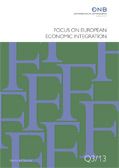Focus on European Economic Integration Q3/15
 OeNB
OeNB
- Erschienen:
- September 2015.
 OeNB
OeNB
Focus on European Economic Integration Q3/15 (PDF, 1,7 MB) September 2015.
Call for entries: Olga Radzyner Award 2015 (PDF, 52 kB) 30.09.2015, 00:00:00
Call for applications: Visiting Research Program (PDF, 51 kB) 30.09.2015, 00:00:00
Business cycle synchronization between the Western Balkans and the European Union (PDF, 834 kB) Hildebrandt, Moder. Antje Hildebrandt, Isabella Moder This paper investigates the degree of business cycle synchronization (BCS) between the Western Balkans and the European Union. While the degree of synchronization had been low or even negative before 2000, business cycles have clearly converged ever since. Since 2010, in particular, BCS with the EU has been high for all Western Balkan countries. In addition, this paper empirically tests which factors were responsible for the convergence process. Using a period-by-period correlation index for the time span from 1994 to 2013, we find that foreign trade is the most important positive contributor to business cycle convergence. Although fiscal differences are associated with negative BCS in the same year, our results suggest that they have a positive influence in subsequent periods. In contrast, we find that financial flows lead to business cycle decoupling because of their procyclical behavior in the respective domestic economy. The same relationship applies, according to our analysis, to remittances, whose impact on BCS is an underresearched topic in the empirical literature. We find that remittances from the EU to the Western Balkans behave similarly to financial flows, which supports the hypothesis that remittances are sent home to take advantage of favorable economic conditions. business cycles, convergence, Western Balkans, European integration, remittances E32, E58, F15, F24, F36 30.09.2015, 00:00:00
Current risks in the CESEE residential property market: evidence from the OeNB Euro Survey (PDF, 653 kB) Beckmann, Hildebrandt, Jäger-Gyovai. Elisabeth Beckmann, Antje Hildebrandt, Krisztina Jäger-Gyovai After a pronounced boom-bust cycle during the global financial crisis, house prices in Central, Eastern and Southeastern Europe (CESEE) are now recovering but still remain below precrisis levels. Evidence from the OeNB Euro Survey of households shows that every third household considers finding a new residence difficult, with the perceived difficulty being particularly high in areas of low bank penetration and among low income households and households whose highest level of education is primary education. Foreign currency mortgage holders are found to be more frequently in arrears in Hungary and Serbia than in other CESEE countries; the exchange rate and interest rate differential risks of foreign currency mortgages have increased in several countries, however. Loan arrears are high in general, and households in arrears are at their financial limits. At the same time, demand for housing loans is found to be increasing again. residential property markets, housing finance, household survey, Central, Eastern and Southeastern Europe D14, F36, P2, P5, R21, R3 30.09.2015, 00:00:00
Internal capital markets and crisis transmission: evidence from foreign bank subsidiaries in CESEE (PDF, 491 kB) Vujic. Vukan Vujić, Olga Radzyner Award winner 2014 The aim of this paper is to analyze the impact of European bank deleveraging on the asset growth of European banks’ CESEE subsidiaries. Our estimation of the effects of parent bank funding on subsidiaries’ asset growth relies on the instrumental variables strategy, instrumenting for intragroup flows with exposure to the sovereign debt of Ireland, Greece, Spain and Portugal. The novelty of this analysis is the differentiation between equity and nonequity intragroup flows and the inclusion of a significant number of countries in the sample. Previous studies in this area either did not analyze the role of equity flows or focused on one country only. The present study finds that intragroup flows have a significant effect on subsidiaries’ asset growth. A 1 percentage point increase in equity flows leads to a 6.1 percentage point increase in assets; the same increase in nonequity flows leads to a 1.7 percentage point increase in assets. This finding has significant policy implications for the regulation of domestic banks and cross-border regulatory cooperation. deleveraging, multinational banks, related party transactions F23, F36, G21 30.09.2015, 00:00:00
CESEE-related abstracts from other OeNB publications (PDF, 84 kB) 30.09.2015, 00:00:00
77th East Jour Fixe: Russia – economic turmoil and policy options (PDF, 89 kB) Compiled by Stephan Barisitz 30.09.2015, 00:00:00
Recent research stays at the OeNB’s Foreign Research Division (PDF, 60 kB) Riikka Nuutilainen, Marcela Veselkova 30.09.2015, 00:00:00
Notes (PDF, 122 kB) 30.09.2015, 00:00:00